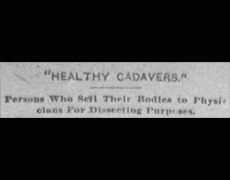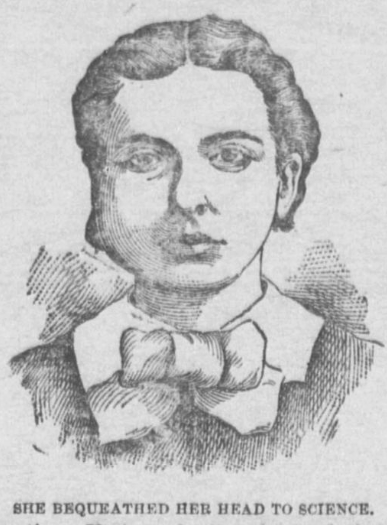
Imagine having the opportunity to sell your cadaver while you are still alive.
Healthy Cadavers

The science of surgery is at present largely directed toward discovering the nature of abnormal growths, unusual diseases and deformities.
The doctors at the hospitals keep a keen lookout for cases which seem likely to develop something of extraordinary interest.
A plan has been adopted of making a bargain with a person suffering with some extraordinary affliction, which binds him to have delivered to the surgeon at death either the entire body or such part of it as may be specified in the contract, and which is likely to prove of peculiar value from a surgical standpoint.
These contracts are regularly drawn up, signed and witnessed.
Persons whose bodies have been thus contracted for are known among doctors as “healthy cadavers,” a paradoxical and somewhat disrespectful term, but sufficiently explanatory.
In transactions of this sort every detail is conducted with perfect delicacy, says the New York World. If the patient is suffering from some incurable disease, from the effects of which the physicians have made up their minds that he must die in a given time, the news is gently broken to his friends, a contract is drawn and signed, and the patient pursues the even tenor of his way in blissful ignorance that his days are numbered or that a price has been set on his body.
If he has no relatives or friends, he is delicately approached by the physician, and the facts are revealed with all possible consideration. He is made to understand that death is sure to come after a certain period, and a round sum is offered. If he be at all reasonable and open to conviction, he will invariably accept the money and sign the contract.
In the museum of Bellevue hospital are a number of specimens taken from “healthy cadavers,” which the late Professor Wood regarded as valuable in showing the progress made by modern surgery.

One which attracts particular attention is that representing a reproduction of a jawbone after removal of the inferior maxilla. The jawbone can be seen in its place in the skull of a patient, who was a rather good looking woman, according to her photograph. She had been employed in a match factory and had contracted necrosis of the bone of the lower jaw from the fumes of phosphorus, inhaled while at work. She lived for some years with the substitute jawbone, and at death, as a token of gratitude to Professor Wood, she bequeathed her head to him for scientific purposes.
Of course it is not always certain that the patient will die before the physician, and this fact has led to some rather curious consequences. One patient at Bellevue hospital, who has been there longer than any other, has reaped quite an income from repeated sales of his head. It seems to be a part of the ethics of this peculiar bargaining that, in case the patient survives the surgeon, he shall be at liberty to enter into another contract.
This Bellevue patient’s name is Mike Kelly. He is a small man, about 55 years old, and suffers from six tumors on the right side of the face. Mr. Kelly attracted the attention of Professor John R. Wood, of the hospital, who has made a specialty of tumors. A careful examination showed that they were incurable, and that an attempt to remove them might result fatally.
Finally the professor made an agreement by which Kelly, in consideration of a certain sum, was to allow his head, after death, to be delivered over for examination. Dr. Wood exhibited Kelly as a curiosity in which he had a proprietary interest and proudly related to his fellow physicians how he had secured the tumors all for his own use after Mr/ Kelly’s demise. Soon afterward the doctor died.
Mr. Kelly then contracted with another physician in the hospital for the disposal of his head. This pledge, like the previous one, was dissolved by the death of the physician, and Mr. Kelly smiled softly. At last account he had made another contract, and except for the tumors was in the enjoyment of perfect health.
Source: The Carbon advocate. (Lehighton, Pa.), 18 Nov. 1893.

